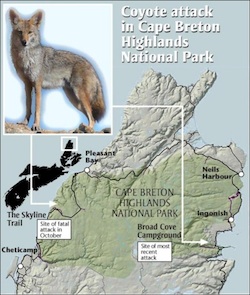11 Aug Herald vs. coyotes
Squad Helps Dog Bite Victim is the title of a 1980 compendium of unintended double-entendre headlines collected by the Columbia Journalism Review. It illustrates the power of tiny punctuation flubs — in this case, a missing hyphen — to radically alter meaning. Readers also have to chuckle in wonderment over how small a town must be for the local newspaper to deem dog bites newsworthy.
When the dog is a coyote, however, and the person bitten is a 16-year-old girl in a National Park where a 19-year-old woman was killed by coyotes 10 months ago, there’s no doubt about newsworthiness. Still, consider how differently two daily newspapers reported the story:
“Coyote bites sleeping teen in head,” was the Cape Breton Post‘s accurate but subdued headline.
INGONISH — A teenage girl was bitten by a coyote early Monday morning in the same national park in Cape Breton where a woman was killed by the animals last year.
“Coyote attacks girl in Highlands,” screamed the Halifax Chronicle-Herald in a headline that spanned the top of page one.
A second vicious coyote attack on a visitor at Cape Breton Highlands National Park prompted park wardens to start setting traps early Monday morning.
A photo of a sinister, prowling coyote illustrated the Herald story, together with a graphic showing a second coyote posing triumphantly astride a map of the Cape Breton Highlands. Lines connected the posing coyote to the sites of the two incidents, which took place 40 kilometres apart, separated by the least hospitable terrain in the Maritimes.
The two stories, both written by competent, journeymen reporters, agreed on the relatively benign facts of the case — a couple of bites to the back of the head, requiring a few stitches at outpatients. The Post’s overall treatment of the event was consistent with these facts. The Herald, by contrast, contrived to hype the story and frighten readers with lurid adjectives, illustrations, and headlines. I’m curious to know whether the unwarranted “vicious” was composed by the reporter, or added later by the desk.
The Herald has long had an outsized appetite for bad news from Cape Breton. Whether staff reductions have contributed to its recent drift into sensationalism (see examples here, here, here, and here) is a topic for another day. For now, it’s enough to point out the striking differences in the two papers’ treatment of a coyote bite.
Hat tip: SP.

